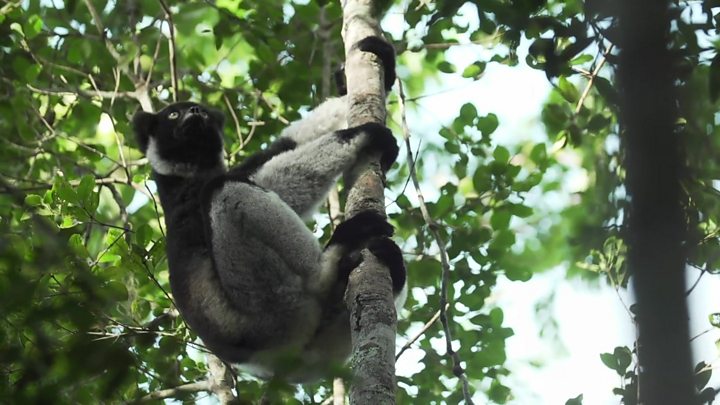
Image copyright
Victoria Gill
A third of all the lemur species on Earth are “one step from extinction”.
This is according to the latest update of the Red List, the comprehensive, continually updated report on the status of species.
Human activities, particularly deforestation and hunting, drive the declines in these unique primates.
Such habitat destruction has also been linked to an increased risk of wildlife diseases – like the coronavirus – spilling over into human populations.
Image copyright
Russell A. Mittermeier
The update shows that 33 lemur species – primates unique to Madagascar – are now classified as Critically Endangered, with 103 of the 107 surviving species threatened with extinction. Thirteen lemur species have been “uplisted” – pushed to higher threat categories as a result of these “intensifying human pressures”.
Craig Hilton-Taylor from the International Union for Conservation of Nature (IUCN), which produces the list, told BBC News that the current pandemic should give us pause to “ask some difficult questions about our relationship with the natural world”.
- Coronavirus: This is not the last pandemic
- Humans ‘threaten 1m species with extinction’
- Covid recovery could ‘tip the balance’ for nature
“We need to look to nature to provide future solutions to human problems – like treatments for disease and food supplies,” Dr Hilton-Taylor added.
“Nature has a huge amount to offer us, but if we continue to impact the natural world as we’re doing – and if we lose species like lemurs – then our chances of looking to nature for those solutions is reduced dramatically.”

Media playback is unsupported on your device
Updates to the list are based on the latest scientific assessments. There are now more than 120,000 different species that have been assessed, with 120,372 species now listed and, of these, 32,441 are threatened with extinction.
Image copyright
Anderson Cabot Center for Ocean Life
Other species that have been “uplisted” include:
- The North Atlantic Right Whale (Eubalaena glacialis) has been moved from Endangered to Critically Endangered, with fewer than 250 mature individuals estimated to be alive at the end of 2018;
- The European Hamster (Cricetus cricetus), a common pet that was once abundant in the wild across Europe and Russia. It is now listed as Critically Endangered. Reasons for its population declines across Europe and Russia are not clear, but scientists believe that the animal’s reproduction rates have fallen – something that may be linked to light pollution and climate change;
- The world’s most expensive fungus, Caterpillar Fungus (Ophiocordyceps sinensis), has entered the IUCN Red List as Vulnerable. This fungus is highly valued in Traditional Chinese Medicine, where it has been used for millennia to treat diseases including those related to the kidneys and lungs. Demand for the fungus has risen sharply since the 1990s.
Image copyright
Mathilde Tissier
There are some conservation success stories in the latest list. A little known species of iguana native to the Turks and Caicos Islands has been “downlisted” from Critically Endangered to Endangered, meaning it is no longer at immediate threat of extinction.
That is entirely, Craig Hilton-Taylor said, because of a concerted conservation effort on the islands, involving the government, NGOs and local people – restoring habitat and reintroducing the species.
“If people pull together, species can recover,” he added.
Follow Victoria on Twitter
Read MoreFeedzy


